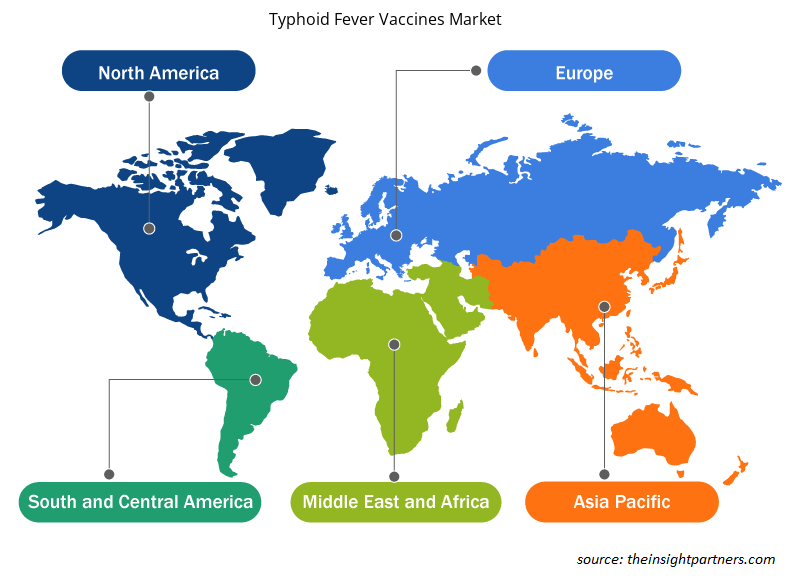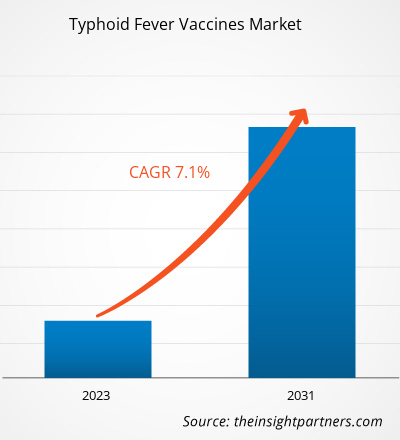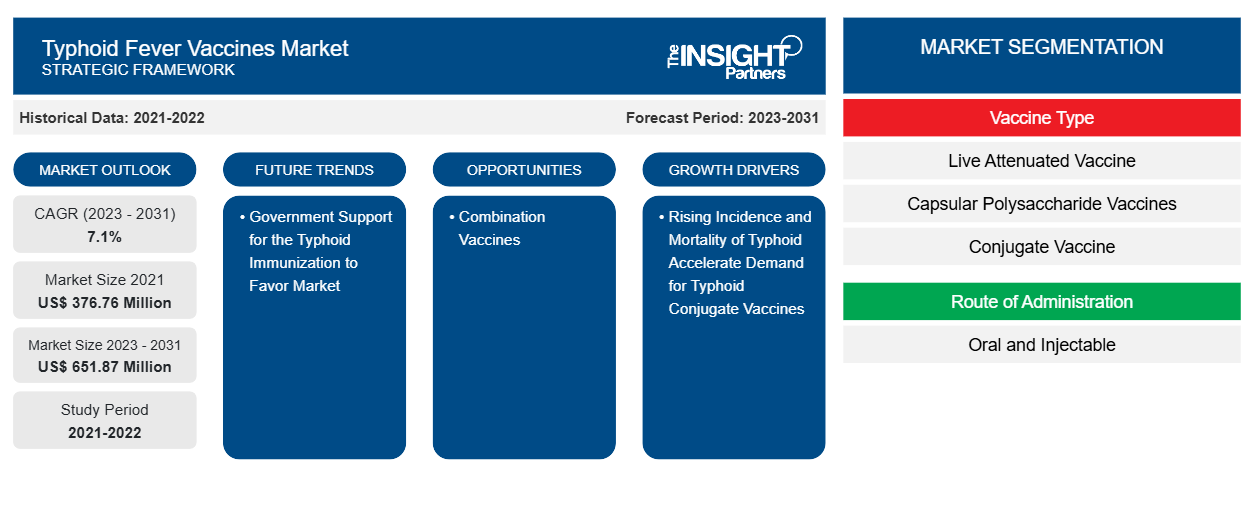Le marché des vaccins contre la fièvre typhoïde était évalué à 376,76 millions USD en 2021 et devrait atteindre 651,87 millions USD d'ici 2031. Le marché devrait enregistrer un TCAC de 7,1 % entre 2023 et 2031. La pénétration des vaccins combinés contre la typhoïde devrait rester l'une des principales tendances du marché des vaccins contre la fièvre typhoïde.
Analyse du marché des vaccins contre la fièvre typhoïde
L'augmentation de l'incidence et de la mortalité de la typhoïde accélère la demande de vaccins conjugués contre la typhoïde
Selon le rapport de mars 2023 de l'Organisation mondiale de la santé (OMS), en 2019, environ 9 millions de personnes sont tombées malades à cause de la fièvre typhoïde et 110 000 personnes en sont mortes chaque année. En outre, les voyageurs présentent un risque élevé de développer la fièvre typhoïde, en particulier en Asie et en Afrique subsaharienne. Par conséquent, avec l'augmentation des cas d'incidence et de mortalité, la demande de vaccins contre la typhoïde est plus élevée que jamais. Par exemple, l'OMS conseille aux pays d'adopter la vaccination par vaccins conjugués contre la typhoïde (TCV) pour contrôler la maladie dans les régions endémiques. Le TCV est le premier vaccin contre la typhoïde adapté aux enfants à partir de six mois et est le choix de vaccin contre la typhoïde le plus préféré au monde. Le modèle mondial du marché des vaccins (GVMM) a estimé que les revenus totaux du marché du TCV dans les pays à revenu intermédiaire (PRI) et les pays à faible revenu (PFR) devraient atteindre 44 millions de dollars américains, ce qui ne représente qu'une part de marché d'environ 14 %.
Source : GVMM
En outre, le Fonds des Nations Unies pour l'enfance (UNICEF) détient plus de 95 % des parts de marché du vaccin TCV, en particulier en Afrique subsaharienne et en Asie du Sud et du Sud-Est pour les pays à faible revenu et les pays à revenu intermédiaire. L'approvisionnement adéquat en vaccins TCV en Afrique subsaharienne et en Asie du Sud et du Sud-Est est assuré par l'UNICEF afin de réduire la forte prévalence des cas de fièvre typhoïde au sein de la population. Par conséquent, la prévalence et la mortalité croissantes associées à la fièvre typhoïde et la demande et l'offre appropriées de vaccins contre la typhoïde dans les pays épidémiques sont les facteurs d'influence responsables de la croissance du marché des vaccins contre la fièvre typhoïde au cours de la période 2021-2031.
Aperçu du marché des vaccins contre la fièvre typhoïde
L'intervention gouvernementale et les solutions intelligentes d'administration de vaccins continuent d'influencer considérablement les vaccins contre la fièvre typhoïde. Le soutien gouvernemental à la vaccination contre la typhoïde et l'augmentation de l'incidence et de la mortalité de la typhoïde sont les facteurs les plus influents responsables de la croissance du marché des vaccins contre la fièvre typhoïde. Les vaccins combinés contre la typhoïde sont une tendance clé pour la croissance du marché des vaccins contre la fièvre typhoïde. Les études précliniques pour le développement d'un vaccin glycoconjugué trivalent contre la typhoïde/salmonelle non typhoïde offriront une opportunité de marché lucrative.
Personnalisez ce rapport en fonction de vos besoins
Vous bénéficierez d'une personnalisation gratuite de n'importe quel rapport, y compris de certaines parties de ce rapport, d'une analyse au niveau des pays, d'un pack de données Excel, ainsi que de superbes offres et réductions pour les start-ups et les universités.
-
Obtenez les principales tendances clés du marché de ce rapport.Cet échantillon GRATUIT comprendra une analyse de données, allant des tendances du marché aux estimations et prévisions.
Vaccins contre la fièvre typhoïdeMoteurs et opportunités du marchéVaccinesMarket Drivers and Opportunities
Le soutien du gouvernement à la vaccination contre la typhoïde favorise le marché
Le soutien des gouvernements à la vaccination contre la typhoïde accélère la demande de vaccins à l’échelle mondiale. Par exemple, le rapport du Commonwealth d’Australie révèle qu’il est recommandé aux enfants de moins de 2 ans et aux adultes de se faire vacciner contre la typhoïde s’ils voyagent dans des régions épidémiques telles que l’Afrique subsaharienne et l’Asie du Sud et du Sud-Est. En outre, les enfants de moins de 2 ans et les adultes peuvent recevoir une dose de vaccin parentéral contre la typhoïde, et les enfants de plus de 6 ans et les adultes peuvent recevoir 3 ou 4 doses de vaccin oral contre la typhoïde.
De plus, au Canada, la vaccination contre la typhoïde est obligatoire pour les voyageurs de plus de 2 ans qui se rendent en Asie du Sud, notamment en Afghanistan, au Bangladesh, au Bhoutan, en Inde, aux Maldives, au Népal, au Pakistan et au Sri Lanka. Par conséquent, le soutien gouvernemental au programme de vaccination contre la typhoïde contribuera davantage à la croissance exponentielle du marché des vaccins contre la fièvre typhoïde au cours de la période 2021-2031.
Études précliniques pour le développement d’un vaccin glycoconjugué trivalent contre la salmonelle typhoïde/non typhoïde – Une opportunité
En février 2024, SK Bioscience et l'International Vaccine Institute (IVI) ont annoncé que le vaccin conjugué contre la typhoïde développé par SK Bioscience avait obtenu la préqualification de l'OMS (PQ) pour l'achat public du vaccin par les organisations des Nations Unies, ce qui a permis de stimuler l'approvisionnement mondial en vaccin conjugué contre la typhoïde. Les résultats de l'essai clinique de phase 2 du rappel « SKYTYPHOID » révèlent que les deux doses du vaccin conjugué contre la typhoïde chez les nourrissons âgés de 6 à 23 mois ont développé une forte réponse immunitaire.
En outre, plusieurs fabricants développent des vaccins antityphoïdiques qui sont au stade préclinique. Par exemple, les fabricants développent un vaccin glycoconjugué trivalent contre la typhoïde et la salmonelle non typhoïde, en particulier pour la population d'Afrique subsaharienne. De plus, le développement d'un vaccin contre la typhoïde et la paratyphoïde A basé sur un système de présentation d'antigènes multiples (MAPS) est encore au stade préclinique et constitue une alternative prometteuse au vaccin conjugué traditionnel. Par conséquent, les études cliniques visant à développer un vaccin innovant contre la typhoïde offriront des opportunités de marché lucratives aux fabricants qui, à terme, stimuleront le marché des vaccins contre la fièvre typhoïde.
Vaccins contre la fièvre typhoïde
Analyse de segmentation du rapport de marché
Les segments clés qui ont contribué à l’élaboration de l’analyse du marché des vaccins contre la fièvre typhoïde sont la candidature et les services.
- En fonction du type de vaccin, le marché des vaccins contre la fièvre typhoïde est segmenté en vaccins vivants atténués, vaccins à base de polysaccharides capsulaires, vaccins conjugués, etc. Les vaccins à base de polysaccharides capsulaires pourraient détenir une part de marché plus importante en 2023.
- En fonction de la voie d'administration, le marché des vaccins contre la fièvre typhoïde est divisé en vaccins oraux et injectables. Le segment injectable pourrait détenir une part de marché plus importante en 2023.
Analyse des parts de marché des vaccins contre la fièvre typhoïde par zone géographique
La portée géographique du rapport sur le marché des vaccins contre la fièvre typhoïde est principalement divisée en cinq régions : Amérique du Nord, Asie-Pacifique, Europe, Moyen-Orient et Afrique, et Amérique du Sud/Amérique du Sud et centrale.
L'Amérique du Nord a dominé le marché des vaccins contre la fièvre typhoïde. En Amérique du Nord, les États-Unis représentent une part considérable des vaccins contre la fièvre typhoïde. L'Amérique du Nord représente la plus grande part de marché des vaccins contre la typhoïde et les revenus dus à l'augmentation des dépenses de santé et au développement de vaccins innovants grâce aux essais cliniques sont les facteurs les plus influents responsables de la croissance du marché. L'Asie-Pacifique devrait connaître le TCAC le plus élevé dans les années à venir.
Vaccins contre la fièvre typhoïde
Aperçu régional du marché des vaccins contre la fièvre typhoïde
Les tendances et facteurs régionaux influençant le marché des vaccins contre la fièvre typhoïde tout au long de la période de prévision ont été expliqués en détail par les analystes d’Insight Partners. Cette section traite également des segments et de la géographie du marché des vaccins contre la fièvre typhoïde en Amérique du Nord, en Europe, en Asie-Pacifique, au Moyen-Orient et en Afrique, ainsi qu’en Amérique du Sud et en Amérique centrale.

- Obtenez les données régionales spécifiques au marché des vaccins contre la fièvre typhoïde
Portée du rapport sur le marché des vaccins contre la fièvre typhoïde
| Attribut de rapport | Détails |
|---|---|
| Taille du marché en 2021 | 376,76 millions de dollars américains |
| Taille du marché d'ici 2031 | 651,87 millions de dollars américains |
| Taux de croissance annuel composé mondial (2023-2031) | 7,1% |
| Données historiques | 2021-2022 |
| Période de prévision | 2023-2031 |
| Segments couverts |
Par type de vaccin
|
| Régions et pays couverts |
Amérique du Nord
|
| Leaders du marché et profils d'entreprises clés |
|
Densité des acteurs du marché des vaccins contre la fièvre typhoïde : comprendre son impact sur la dynamique commerciale
Le marché des vaccins contre la fièvre typhoïde connaît une croissance rapide, tirée par la demande croissante des utilisateurs finaux en raison de facteurs tels que l'évolution des préférences des consommateurs, les avancées technologiques et une plus grande sensibilisation aux avantages du produit. À mesure que la demande augmente, les entreprises élargissent leurs offres, innovent pour répondre aux besoins des consommateurs et capitalisent sur les tendances émergentes, ce qui alimente davantage la croissance du marché.
La densité des acteurs du marché fait référence à la répartition des entreprises ou des sociétés opérant sur un marché ou un secteur particulier. Elle indique le nombre de concurrents (acteurs du marché) présents sur un marché donné par rapport à sa taille ou à sa valeur marchande totale.
Les principales entreprises opérant sur le marché des vaccins contre la fièvre typhoïde sont :
- Immunologie indienne
- LBIP
- Finlay
- Incepta
- Panacée
- Bharat Biotech
Avis de non-responsabilité : les sociétés répertoriées ci-dessus ne sont pas classées dans un ordre particulier.

- Obtenez un aperçu des principaux acteurs du marché des vaccins contre la fièvre typhoïde
Vaccins contre la fièvre typhoïdeActualités du marché et développements récents
Le marché des vaccins contre la fièvre typhoïde est évalué en collectant des données qualitatives et quantitatives après des recherches primaires et secondaires, qui comprennent des publications d'entreprise importantes, des données d'association et des bases de données. Voici une liste des développements sur le marché des vaccins contre la fièvre typhoïde et des stratégies :
- En novembre 2023, la République de Corée a annoncé qu'un nouveau vaccin conjugué contre la typhoïde, le « vaccin conjugué contre la typhoïde Bio-TCV (TCV) », serait homologué en Indonésie après l'approbation de la commercialisation par Badan Pengawas Obat dan Makanan (BPOM), l'autorité nationale de réglementation. Le nouveau vaccin, « Bio-TCV », est un vaccin conjugué à base de polysaccharide Vi.
Rapport sur le marché des vaccins contre la fièvre typhoïde - Couverture et livrables
Le rapport « Taille et prévisions du marché des vaccins contre la fièvre typhoïde (2021-2031) » fournit une analyse détaillée du marché couvrant les domaines ci-dessous :
- Taille du marché et prévisions aux niveaux mondial, régional et national pour tous les segments de marché clés couverts par le périmètre
- Dynamique du marché, comme les facteurs moteurs, les contraintes et les opportunités clés
- Principales tendances futures
- Analyse détaillée des cinq forces de PEST/Porter et SWOT
- Analyse du marché mondial et régional couvrant les principales tendances du marché, les principaux acteurs, les réglementations et les développements récents du marché
- Analyse du paysage industriel et de la concurrence couvrant la concentration du marché, l'analyse de la carte thermique, les principaux acteurs et les développements récents
- Profils d'entreprise détaillés
- Analyse historique (2 ans), année de base, prévision (7 ans) avec TCAC
- Analyse PEST et SWOT
- Taille du marché Valeur / Volume - Mondial, Régional, Pays
- Industrie et paysage concurrentiel
- Ensemble de données Excel
Rapports récents
Témoignages
Raison d'acheter
- Prise de décision éclairée
- Compréhension de la dynamique du marché
- Analyse concurrentielle
- Connaissances clients
- Prévisions de marché
- Atténuation des risques
- Planification stratégique
- Justification des investissements
- Identification des marchés émergents
- Amélioration des stratégies marketing
- Amélioration de l'efficacité opérationnelle
- Alignement sur les tendances réglementaires























 Obtenez un échantillon gratuit pour - Marché des vaccins contre la fièvre typhoïde
Obtenez un échantillon gratuit pour - Marché des vaccins contre la fièvre typhoïde